We like to travel in search of the authentic, the genuine and traditional or simply the picturesque. Gastronomy is one of the most original and interesting things when it comes to getting to know the culture of a place. If you don’t know what to eat in Granada, we’ll explain it to you. Lthe flavours of this land are of sea and mountain. Granada does not have much coastline, but it shares traditions with Malaga and Almeria.
NOTE: We are going to deal with the gastronomy of the province of Granada, but we cannot stop in each place, because otherwise we would have to make a real encyclopaedia!
Remember that we have a comprehensive guide to Granada for those who love to know more.
What you will find here
THE “WHYS” OF GRANADA’S GASTRONOMY
The gastronomy of Granada is conditioned by its geography, its climate and the historical past it shares with other provinces of Andalusia.
GEOGRAPHY AND CLIMATE
To know what to eat in Granada, you need to know Granada. Granada has a “tropical coast”, countryside, middle and high mountains. The Sierra de Almijara and Tejeda mountains border the coast between Almuñécar and Salobreña. The mountains retain humidity and provide a more stable temperature than in other areas of the Mediterranean. Thanks to this peculiar microclimate, species such as avocado, mango and custard apples can be cultivated. Thus the consumption of these fruits is more than common in Granada.
Sierra Nevada is the great mountain massif of Granada, although not the only one. On the north face the cold climate of the shady areas is predominant. There are some cowsheds where animals are reared in semi-freedom (also in the Vega de Granada). On the southern side is the Alpujarra, a unique territory with a mild climate influenced by the sea breeze. Here there is an abundance of ham drying sheds, chestnut trees, fruit trees and vegetable gardens.
The high mountains in Granada provide snow during the winter months and cold to generate high mountain pastures. Although we tend to associate the high mountains of Granada only with the Sierra Nevada, there are other parts of the province that are well above 1500 m. in altitude: the Sierra de Huétor, the Sierra de Baza, the Sierra de Castril with Sagra and even some parts of the Sierra de Almijara.

The high mountain is one of the great conditioning factors of the climate of Granada. The 3000 m. range in Sierra Nevada.
In the centre and north of the provinces there are abundant large extensions of dry farming, especially of almond trees, olive trees and cereals. The landscape is characterised by high plateaus, badlands and arid areas crossed by mountain ranges.
To the west the landscape becomes hilly and olive trees gain ground over all other crops. Grazing is important in the west of Granada and very good cheeses are made here. We tell you more about it below.
Generally speaking, it rains more in Granada than in neighbouring Almería. The high mountains offer melt water that has been used since ancient times. The water favours irrigation, fruit trees and market gardens. The Vega de Granada is the largest and is fed by the river Genil, the main tributary of the Guadalquivir. But each locality in Granada has its own irrigated cultivation area. Vegetables play an important role in Granada’s recipes.
Droughts are one of the main conditioning factors of this territory, especially inland. There are good years and bad years, so crops and farmers are subject to this phenomenon.
THE HISTORICAL PAST
The gastronomy of Granada in particular and that of Andalusia or Spain in general, share with the rest of the neighbouring nations the so-called “Mediterranean triad”. It is attributed to the ancient Romans the extension of this food culture based on the cultivation of vines, olives and wheat.
The next great historical conditioning factor in Granada is the Andalusian culture. Arabs and Berbers connected al-Andalus with the East and increased the list of foods that could be consumed. Of particular importance were fruits and vegetables: citrus fruits, melon, artichoke, sugar! If you are interested in the subject, we recommend this article.
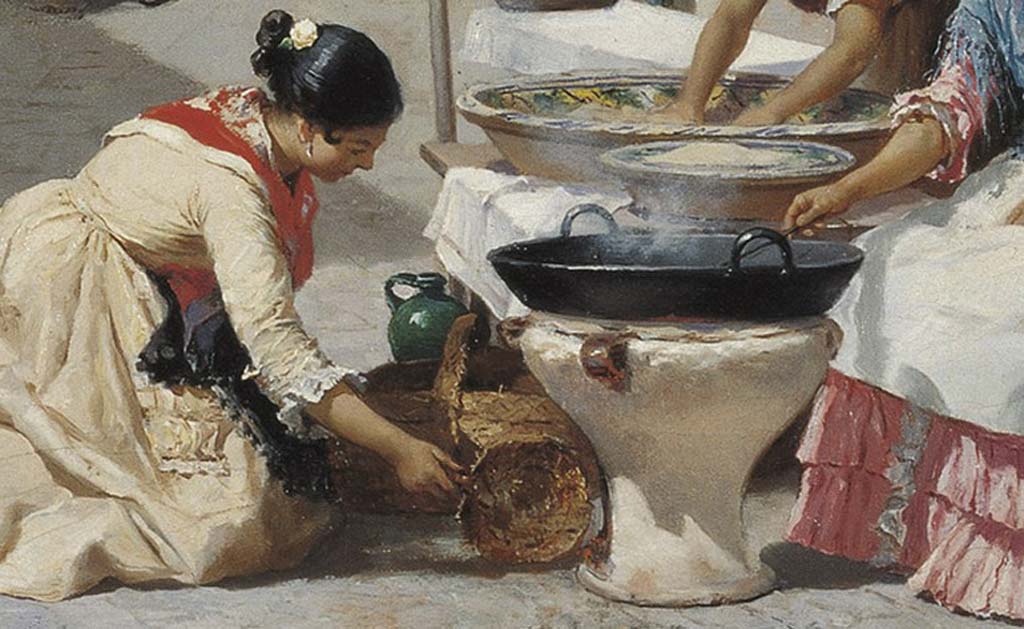
Common pottery in a detail from the canvas Vendedoras de rosquillas en una calle de Sevilla (Manuel Ussel de Guimbarda. Collection Carmen Thyssen-Bornemisza). Lebrillos and cooker from the 19th century, heirs of the Andalusian alcadafes and anafres.
These new crops required a greater water supply. By means of irrigation channels (water channels) they channelled the water from the rivers and ravines to create veritable orchards in the vicinity of the villages (the vegas). You may be interested in reading the post where we talk about the Royal irrigation channel of the Alhambra.
And we come to the end of the 15th century, when one of the great historical events of humanity took place. The then “Spanish Empire” reached the American continent. A flow of goods now began between the two shores, making possible the arrival of such common foods as tomatoes, potatoes and peppers.
FOLLOW US ON OUR “WHAT TO EAT IN GRANADA”
THE RAW MATERIAL
FOR DRYLAND
Olive trees, almonds and cereals (mainly wheat) are the main rainfed crops. Currently, attempts are being made to introduce new rainfed crops such as pistachio. Other cereals such as oats and legumes such as chickpeas and lentils are also grown, but olive trees are gradually gaining ground.
OIL. Talking about olive oil in Andalusia is complicated, as each province has very good cooperatives and companies. But we recommend you to try the organic and most innovative oils from the point of view of cultivation, as is the case of the Almazara Quaryat Dillar. It is very close to Granada, in a village called Dílar. They implement a sustainable way of cultivation where the land is not ploughed, no pesticides are used and the grass is left to grow under the trees, a real example of the future.
PAN DE ALFACAR. In the past, Granada was supplied by its own wheat production. Nowadays most of the wheat consumed in Spain is imported. However, the bread from Alfacar has a “Protected Geographical Indication”. The bread is made in a stone oven, with spring water and aromas of thyme and rosemary. The sourdough bread comes down every day from Alfacar to the capital and has a spectacular wood-fired flavour. Alfacar has a long history of bread making, with records dating back to the 16th century.
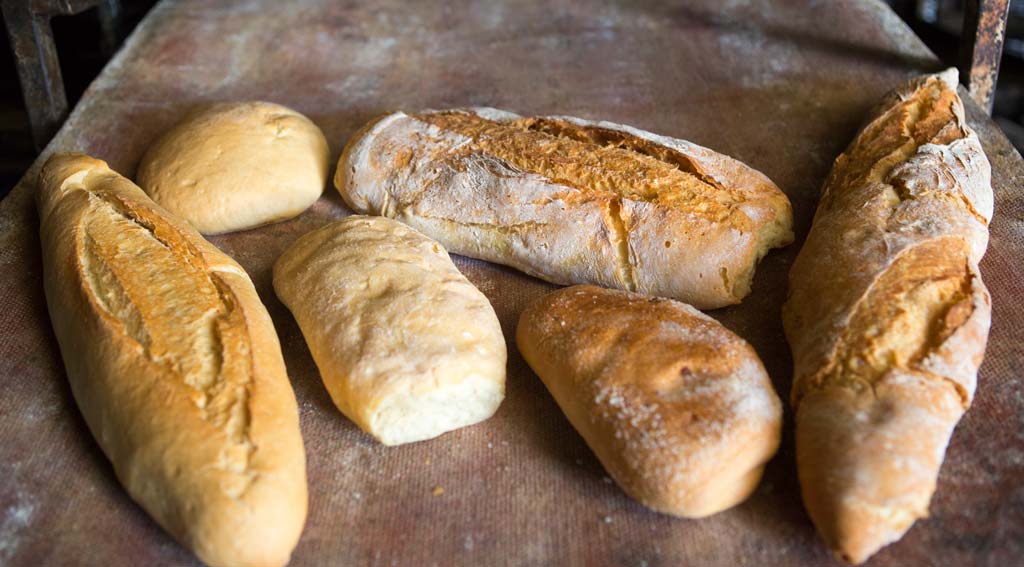
Alfacar bread made in old wood-fired ovens on the left and artisan bakery in Capileira on the right (© Turismo Andaluz S.A. www.andalucia.org).
FROM THE ORCHARD, FROM THE VALLEY
The irrigated land is a key element in the gastronomy of Granada, although in volume it is not comparable to the unirrigated land. We have already spoken of “las vegas”, those areas of orchards that evolved extraordinarily in the Andalusian period and were supplied by irrigation channels. Almost any garden produce can be grown in Granada: peppers, pumpkins, tomatoes, beans, artichokes, etc. But let’s focus on a few that deserve a special mention.
ASPARAGUS. Although wild asparagus is a rainfed plant. In Granada it is cultivated in the fertile plains with water. From mid-March to mid-June it can be found in all the markets and many of the bars and restaurants in Granada. The one in Huétor Tájar is one of the most famous, but it is grown all over the fertile plains of the Genil and in abundance.
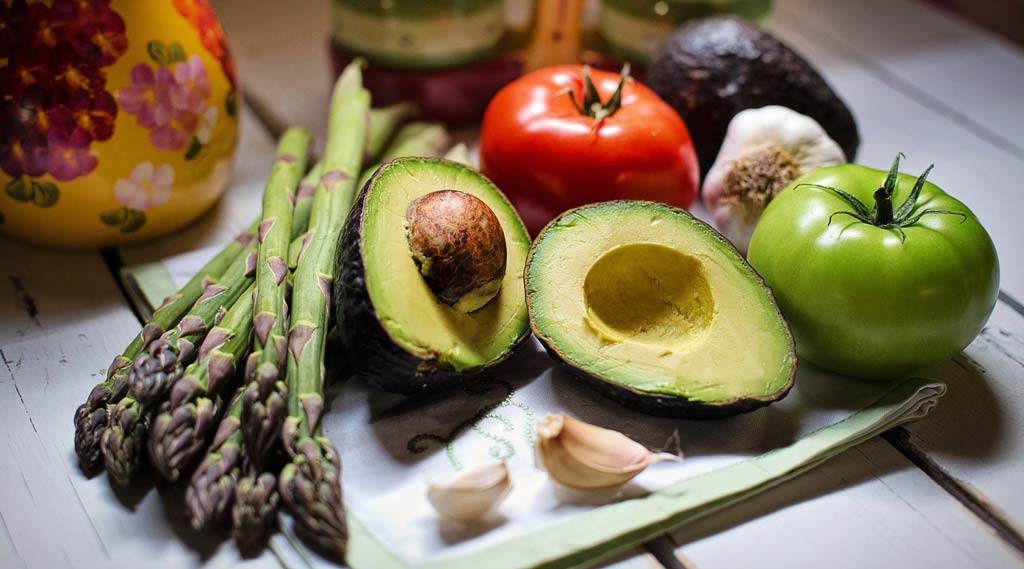
A good representation of the vegetables to eat in Granada.
AGUACATES, CHIRIMOYAS AND MANGOES. We already commented on the tropical coast of Granada above. These exotic fruits are frequently found in Grenadian salads. Although supermarkets have them all year round, they are usually imported. The ones from Granada are better, simply because they are harvested when they are riper.
PEAK PEACHES FROM GUADIX. The peach is a very delicate fruit, best eaten in season. It is grown in Guadix and is of great quality. And in Purullena, very close to Guadix, peaches have their own festival in August and are eaten poached.
DIFFERENT TYPES OF CHERRIES. Both in the Alpujarra and in the area of Güejar Sierra, cherries of extraordinary size and flavour are born every spring. It is also a very perishable fruit, but both in markets and street stalls you will find them native and freshly harvested.
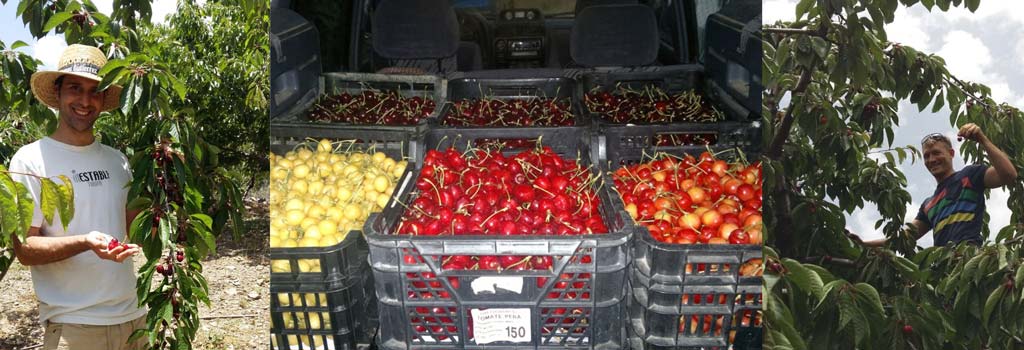
I remember a day picking cherries in our friend Pepe’s farmhouse in Trevélez.
THE BEANS. Every spring, when the broad beans are harvested, it is usual to find stalls selling broad beans next to the fields. Eating broad beans is very typical of Granada, and they are even grown in the Alhambra’s vegetable garden. They can be eaten alone (like seeds) or cooked. The star dish is broad beans with ham, which we tell you about below. It is definitely something you have to eat in Granada.
THE ORANGES. In the Lecrín Valley, oranges and other citrus fruits are grown which are highly valued in the province and beyond. In addition, there are also organic crops that are even sold at home. Remember that the first oranges are more acidic (December) and their flavour becomes sweeter as the months go by (from March onwards approximately).
FROM THE MEDITERRANEAN SEA
Granada, Almeria and Malaga share a seafaring culture as they feed from the same sea, the Mediterranean. The seafood is practically the same and is even prepared in the same way. Some time ago we wrote a post about the gastronomy of Almería, so to avoid repeating ourselves too much we will point out here the most characteristic dishes of Granada.
THE QUISQUILLA OF MOTRIL. On the rocky seabed of the Alboran Sea and off the coast of Motril, this crustacean is fished all year round. Its fame is on the rise and it is probably due to the proximity between the product and its consumers. It can be found in bars in Granada such as the FM or the Bajo de Guía.
PULPO ESPETADO. Not just anywhere will you be able to try the “pulpo espetado” (octopus). In Salobreña there is a unique place where they prepare it on the embers of olive wood. El Peñón restaurant was the first to serve this dish on the beach of Salobreña. Sardine skewers are also common in Granada, although it is better known and more widespread in Malaga.
TRUCHES AND CAVIAR. We are moving away from the sea, but we are still on the water. Specifically, we moved to Ríofrío, a small village in the west of Granada. As its name suggests, it is crossed by a cold water river where trout live naturally. Here the Domezain family set up a trout farm, which years later evolved by adding sturgeons for the production of caviar. Today trout is a typical dish of the area and caviar has put Riofrío on the world map, as it is exported to Russia itself, the birthplace of caviar. Here is a curious video of Chef Gordon Ramsay.
FIELD
Fennel (for stews), many types of mushrooms, collejas (delicious in omelettes), wild asparagus (somewhat bitter), chestnuts (for roasting), thistles (small thistles) and fruits such as blackberries, mulberries and figs (the latter for jams) are harvested in the countryside.
POMEGRANATE CHEESES
Although in the province of Granada there are several areas of medium and high mountain pastures that allow the raising of cows, the cheeses of Granada are mainly made from sheep or goats. They are produced locally almost everywhere in the province.
There are some cheese dairies such as the one in Montefrío or Las RRR in Maracena that have been winning major international awards for years. But we like to focus on the most artisanal and sustainable we recommend you try the cheeses of La Vieja Buchaca. This small cheese factory produces organic goat cheeses from animals that graze freely in the Sierra de Huétor, an exceptional natural environment.
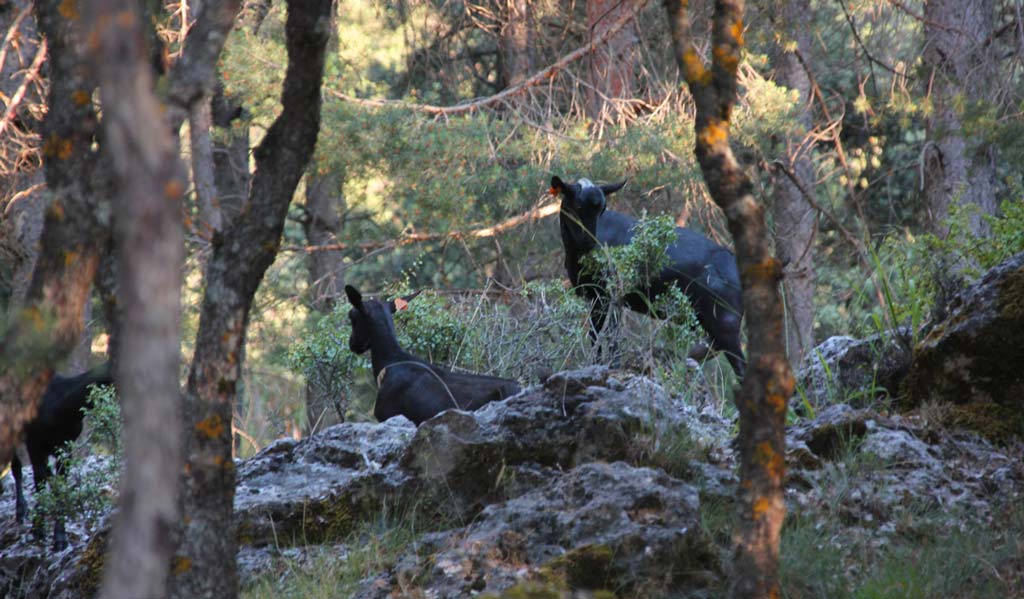
Goats grazing in a privileged natural environment, the Sierra de Huétor (© La Vieja Buchaca).
For us a good souvenir is always something that can be consumed, so taking a good cheese back home is a great idea. Along with those we have already told you about, the cheese dairies of Teatinos (El Padul), Leyva (Guadix), Cortijo del Aserradero (Alhama de Granada) are very interesting options. We love cheese, so it’s an essential thing to eat in Granada, what’s more, it’s an excellent souvenir to take home and share with your loved ones.
WINE
Granada has never been a land of famous wines. However, in recent years several wineries have been creating good wines that coexist with some traditional ones more suited to local palates.
VINO COSTA. It is a rosé wine made with local varieties. It is usually made by the farmers themselves in small cellars. It is typical of the Sierra de la Contraviesa and the Alpujarra. The traditional wine is difficult to find outside this area, but you can drink it in almost every bar and restaurant in the Alpujarra. However, there are bodegas such as Barranco Oscuro that produce this wine commercially.
WINE WINERIES. There are many wineries with a good reputation: Muñana, Señorío de Nevada, Jabalcón, Villagrán. They produce red wines, white wines and other innovative varieties. Some of these wineries even include wine tourism activities and can be visited.
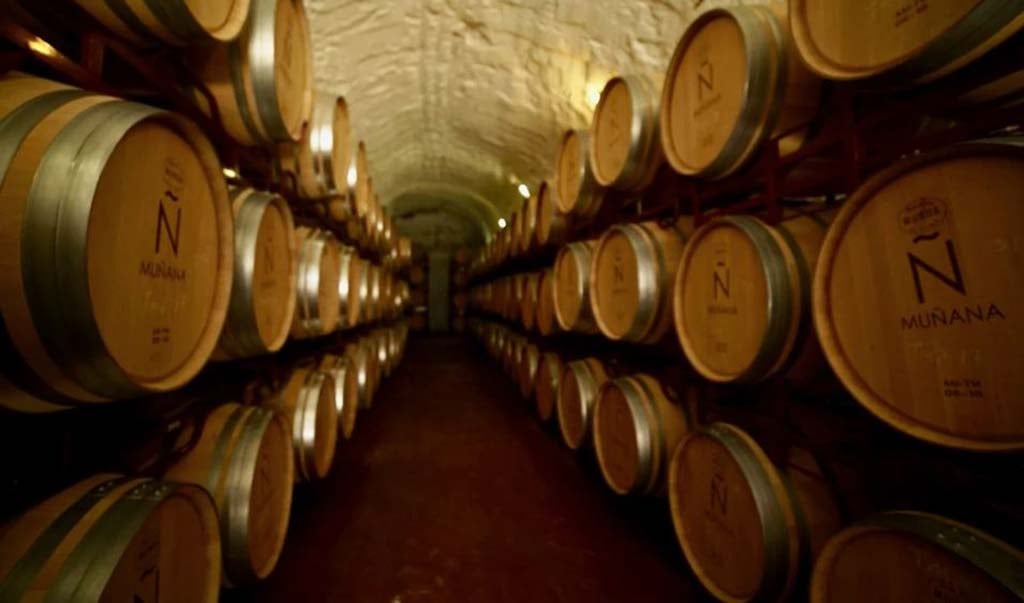
Bodegas Muñana, here is produced one of the best wines of Granada (© Bodegas Muñana).
POETA IN NEW YORK. We like to recommend the traditional things, the ones that have been around forever. Rambla Huarea is a relatively new winery, but one that works in a traditional way and in balance with nature. Moreover, as they say, it is probably the smallest winery in Spain. Poet in New York is the brand name of their wines and it is also the title of a collection of poems written by the illustrious Granada-born Federico García Lorca.
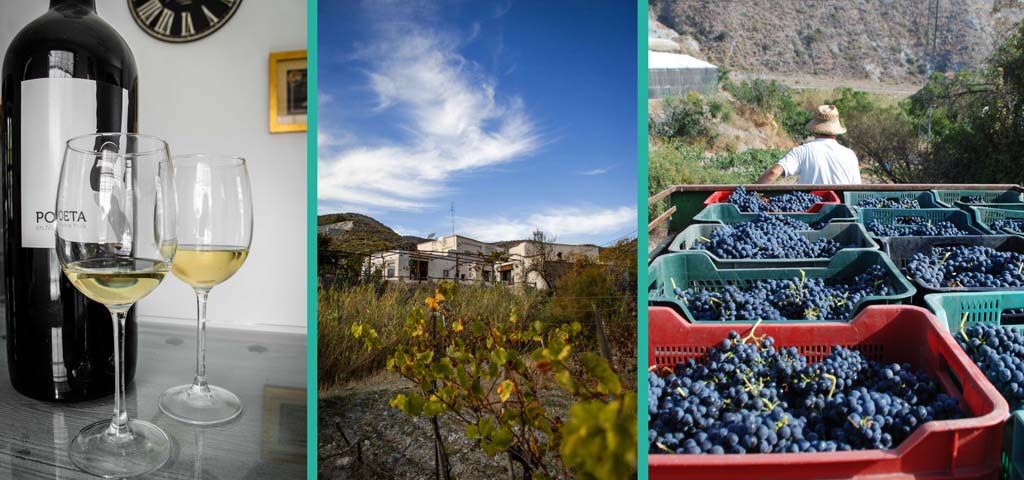
Bodega Rambla Huarea, home of wines Poet in New York.
OTHER ALCOHOLIC BEVERAGES. Granada also produces several craft beers and some alcoholic beverages. The most famous is Ron Montero, a company born in the 60’s in Motril. If you go out for a drink, try the Pálido or Reserva rum. Unlike other companies that have relocated their production, Ron Montero is still produced on the coast of Granada.
MEATS
As we have already seen, Granada abounds in high mountains. Dry climates and low temperatures facilitate the drying of sausages. There are drying sheds in the area of the Alpujarra, Baza, Guadix or even the north face of the Sierra Nevada.
JAMÓN SERRANO (JAM). Although it is up to each person to choose the one they like best, Trevélez ham has a special reputation. This Alpujarran village is one of the highest in Spain. But its fame does not come so much from that, but from a concession by Isabel II in 1862. In a foodstuffs competition, the Queen granted the privilege of identifying the hams with a fire-marked seal of the Royal Crown.
CORDERO SEGUREÑO (LAMB). The “cordero segureño” is a designation of origin for a breed that is reared in the area around the Segura River. It covers several provinces, including the north of Granada. It is characterised by being well adapted to mountainous environments and lacking horns and wool on the head. Some farmers raise the sheep in semi-freedom and their meat is highly appreciated for its flavour. You will find this meat in butcher’s shops and good restaurants in Granada.
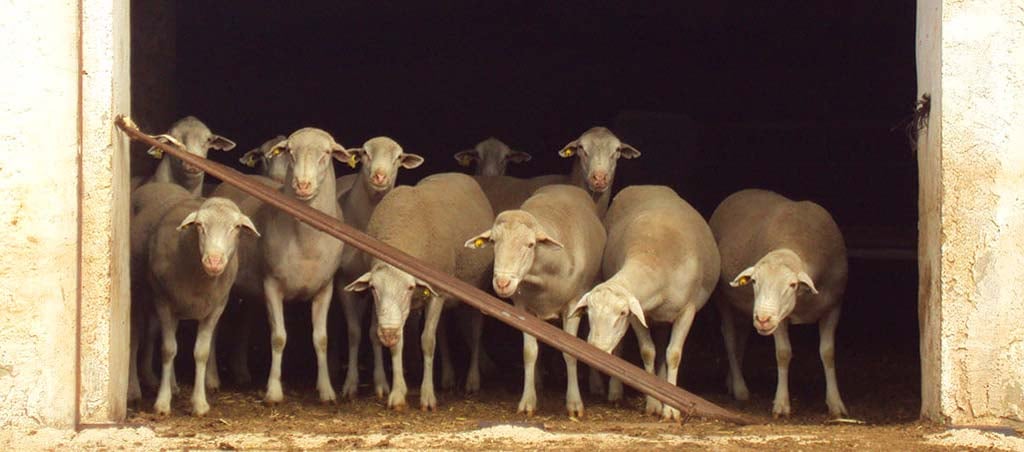
Sheep of the “Raza Segureña”, athletic and white fleece (© IGP Cordero Segureño).
TYPICAL DISHES OF GRANADA
You already know what the food of Granada is like. Now you may be wondering, what can we eat in Granada? Well, let’s now take a look at a few typical dishes from Granada that will delight your gastronomic experience.
APERITIVES
SALAÍLLAS (Saladillas). It is customary, but not the norm, that in the bakeries of Granada they throw small pieces of bread with oil and salt on top. These are the famous “salaíllas”. In other bakeries you can buy them and they are larger. In the Realejo neighbourhood there is a tiny establishment, the Cochi bakery, which works in a 100% artisan way and its salaíllas include garlic and even olives.
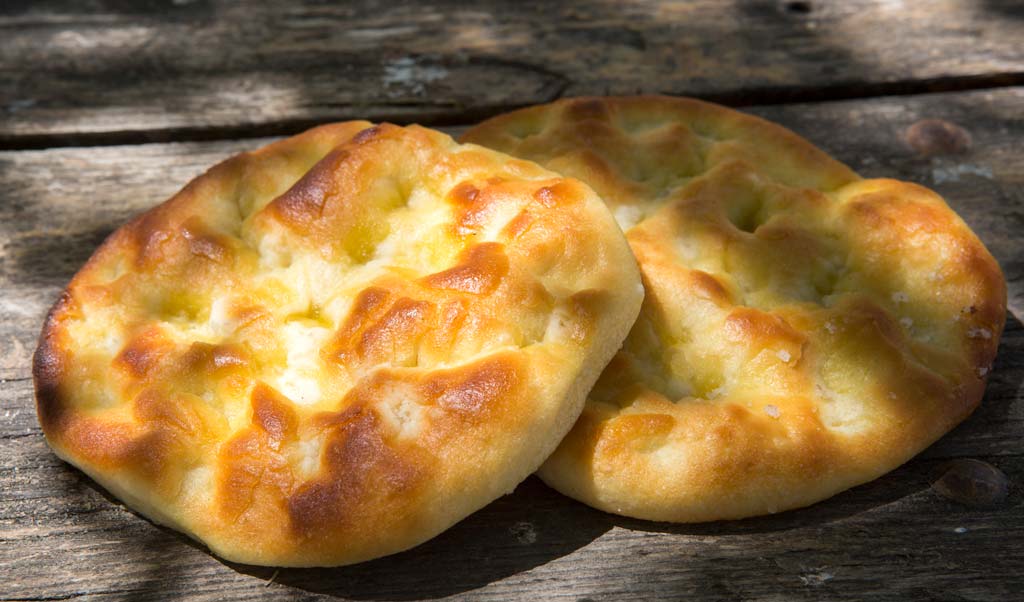
Salaíllas o saladillas granainas (© Turismo Andaluz S.A. www.andalucia.org).
Eating raw beans with saladillas is very typical in the springs of Granada, especially on the Day of the Cross, where they can also be accompanied by cod.
ZALAMANDROÑA. This is an old-fashioned dish, as the base of this meal is dried vegetables, a clever way of preserving food in the absence of freezers. Nowadays we are used to having any food available at any time of the year, but each plant has its own cycle. During the summer, vegetables such as peppers, courgettes, pumpkins and tomatoes were left in the sun. During autumn or winter these products are hydrated and accompanied by raw onion, black olives, oil and other condiments to prepare a very original salad. Nowadays, cod is added, although in the past it must have been other local fish.
TYPICAL DISHES FROM GRANADA
BASASES WITH HAM. We start with perhaps the best-known dish in the gastronomy of Granada. Beans and ham are plentiful in these lands. The key to making them good is to eat them in season (spring), when the beans are tender. If you order them out of season, you will be very disappointed. It is a very simple recipe where the key is the quality of the ingredients and the timing.
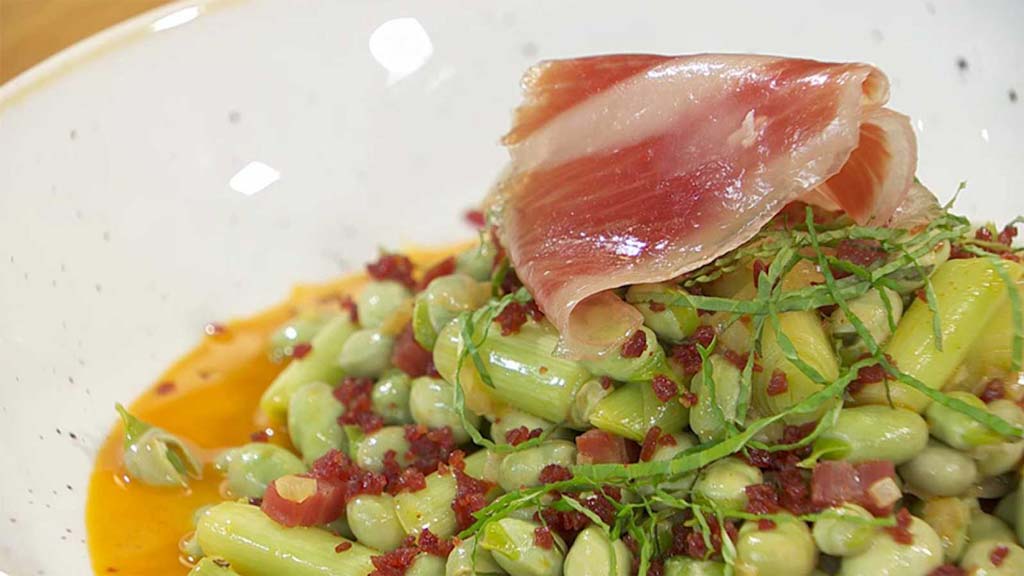
Authentic broad beans with seasonal ham (© RTVE).
OLLA DE SAN ANTÓN. This is a powerful, very granaino stew, especially to combat the cold of January. Its peculiarities are the dried beans, chickpeas, rice and fennel combined with pringá. The “pringá” is a very Andalusian word that encompasses all the meat ingredients of a stew and other stews: lean meat, hock, chorizo, etc. In the case of Olla de San Antón, the pringá usually consists of pig’s tail, ear, cheek, pig’s trotters, bacon, ribs, ham and black pudding, all made from pork.
It is also common in other provinces, but here the tradition of eating it on 17 January remains strongest. On that day, Saint Anthony Abbot, the patron saint of animals, is celebrated. During the second half of January it can be found in restaurants such as El Puntarrón (in Monachil), El Braserito (Realejo neighbourhood), El Camaura or La Cueva de 1900. In Almería it is better known as Olla de Trigo.
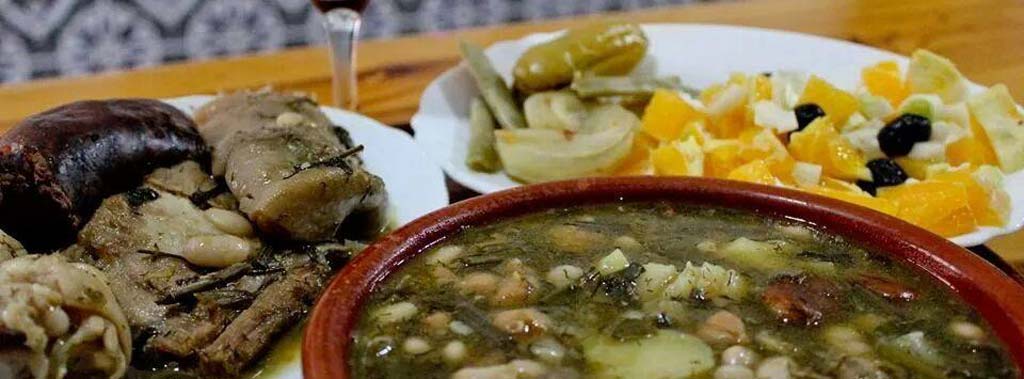
Olla de San Antón of the restaurant el Puntarrón. We recommend the visit not only for the pot of San Antón, its cuisine is 100% artisan and local.
POTAJE DE HINOJOS. It is a much lighter stew than the Olla de San Antón and shares some of the same ingredients. It combines legumes (beans) and cereal (rice) with some good meat toppings: ribs, ham, bacon, black pudding, spine and lean meat. The fennel gives it its name and a very authentic country flavour, both the bulb and the sprout are used. This vegetable is not usually found in supermarkets, but in spring it is plentiful in the fields of Granada. This dish can be prepared without meat and some people prepare it completely vegetarian.
REMOJÓN GRANADINO. Another must-eat dish in Granada is the “remojón”, a very Granadian salad that mixes sweet and savoury. It combines orange, desalted cod, black olives, onion, garlic and may contain other ingredients such as hard-boiled egg. It is seasoned with parsley, bay leaf, vinegar and olive oil. If it contains potatoes, it would be closer to the Malaga cod salad than to the Granada “remojón granadino”.
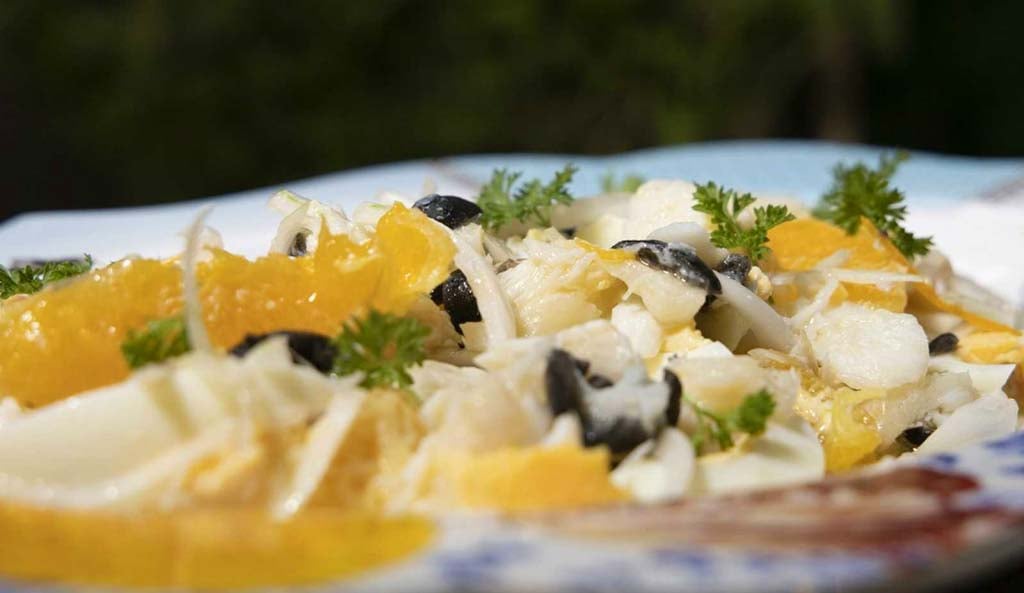
Remojón granadino, a fresh and sweet dish to eat in Granada (© RTVE).
TORTILLA SACROMONTE. It is not an omelette for all palates, although not because of its taste, which is very good, but because of its ingredients. It is made with pig’s brains and pig’s testicles, so it turns many diners away. Although it can be eaten all year round, it is traditionally made on 1 February, the feast day of San Cecilio, the patron saint of Granada. It can be accompanied by other ingredients, it is common to find it with peas, potatoes or ham, among others.
GACHAS PICANTES (we count the sweet ones in the desserts). Porridge is a humble stew consisting of a dough of oatmeal, wheat flour or other cereals. It could be called a poor man’s meal. Porridge has fed a large part of the European population since ancient times. However, in Granada there are many rich and tasty porridge recipes. In Baza they make it spicy with cumin and chilli peppers and can even include anchovies.
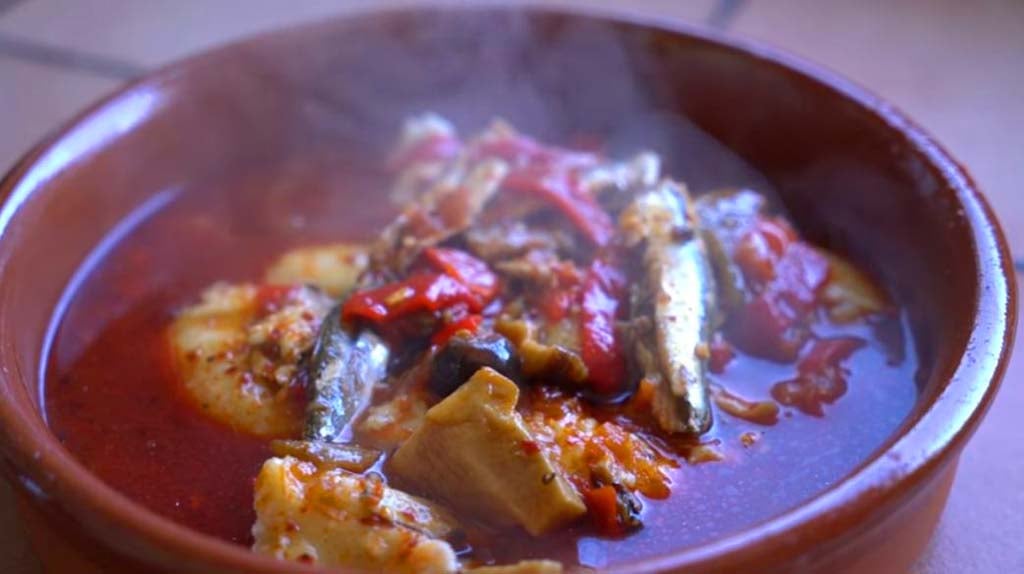
Gachas colorás picantes al estilo bastetano (© Turismo de Baza).
Another variety of porridge very popular in the gastronomy of Granada is the “hormigos”. It is a thicker stew with potatoes that can also be served as an appetizer. It is also present in the kitchens of Almería and Jaén.
EMPEDRADO. With this name we can imagine that the food will not be very light, but the name is more related to its appearance than to its digestion. The combination of legumes (lentils) and cereals (rice) is the key to this dish. It usually has a piece of chorizo sausage which gives it a good flavour. This is going to be difficult to find in a restaurant in the city, but in the villages around Guadix it is a very typical dish.
PLATO ALPUJARREÑO. We have left it for last because it is one of the best known dishes. Poor man’s potatoes with peppers and onions, eggs, ham, lomo en orza, chorizo and black pudding are its ingredients. A calorific dish that was eaten to endure the hard and long days of work in the fields. Beware, it is not suitable for delicate stomachs. You’ll find it in many places, but to try one properly you have to go to a traditional restaurant or take a walk around the Alpujarra.
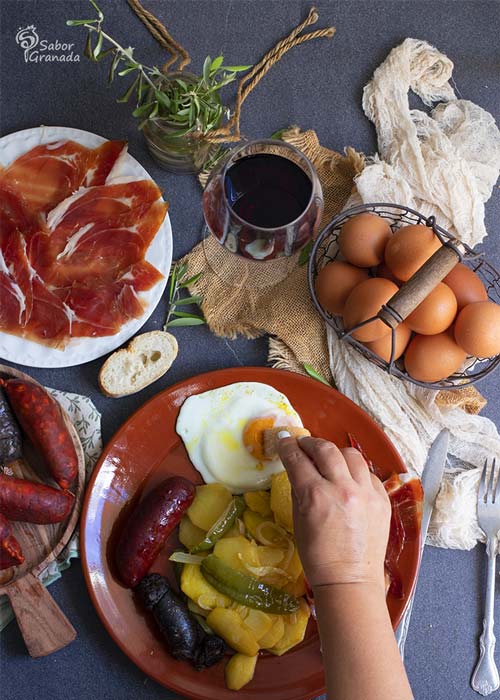
The classic and popular dish from the Alpujarra, ¡a mojar! (© Flavour Granada).
MORAGA DE SARDINAS. This is a stew with sardines and vegetables very original from the coast of Granada and Malaga. It has a traditional and intense flavour due to the fish, the citrus fruits and the wine, but it is not easy to find well made. Some restaurants in Motril and its port serve it very tasty and in a clay casserole made on the grill.
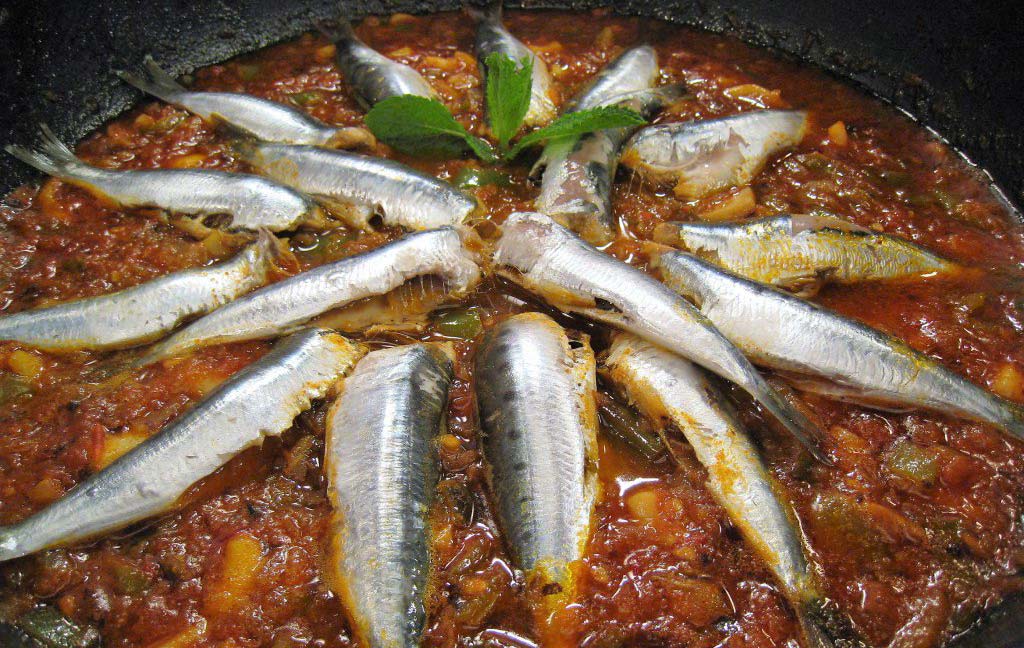
The sardine moraga prepared by the Andalusian chef Enrique Sánchez.
GURUPINA. Like the rest of the traditional stews we have mentioned, in the past it was cooked in large pots for the whole family. They are humble, farmhouse, country meals and, if you manage to taste them well done, with an authentic taste of yesteryear. The dish is prepared with local and tasty food such as dried red pepper, onion, chorizo sausage, garlic, onion, paprika, mushrooms, etc. The flour gives it a texture similar to that of porridge, which is why some consider it as such. It is very typical in the north of Granada such as Baza and Cúllar.
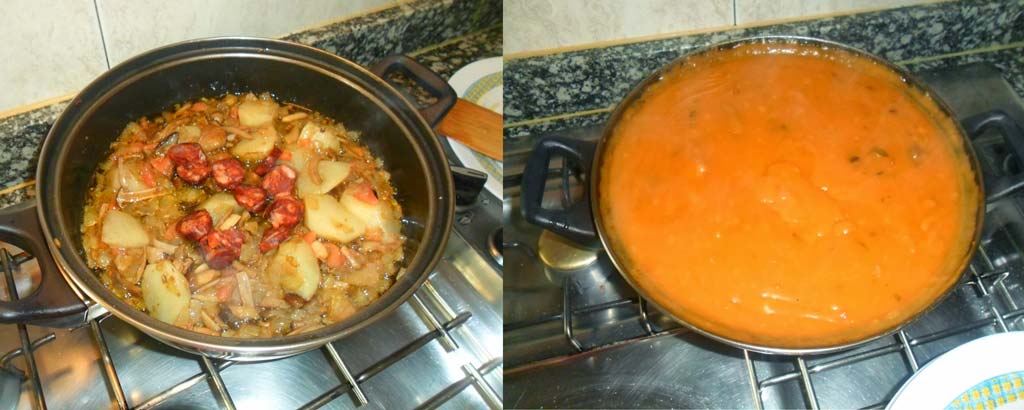
Gurupina in the style of Cúllar (© Turismo de Cúllar).
OTHER HABITUAL DISHES although more common outside Granada are: asaduras, choto al ajillo, berenjenas con miel, caracoles, migas and the fried fish that abounds in the bars of the town.
DESSERTS AND SWEETS
Special section for those with a sweet tooth. Here are the best sweets and sweets to eat in Granada.
PAN DE HIGO. It is a powerful and energetic food based on dried figs, although it can also contain almonds and other nuts. The flavourings are provided by aniseed, cloves, cinnamon and feverfew. In the past, surplus fig fruit was used to make fig bread, as once prepared it can be preserved for long periods of time. It probably has an Andalusian origin, as they cultivated and consumed fig fruits in abundance and were familiar with the stimulating properties of sugar.
It is very common in the southern and mountainous area of the provinces of Granada (Alpujarra and Motril) and Malaga (Axarquia). But we can find it very similar on the Mediterranean coast of Spain, Extremadura, some places in Portugal, etc.
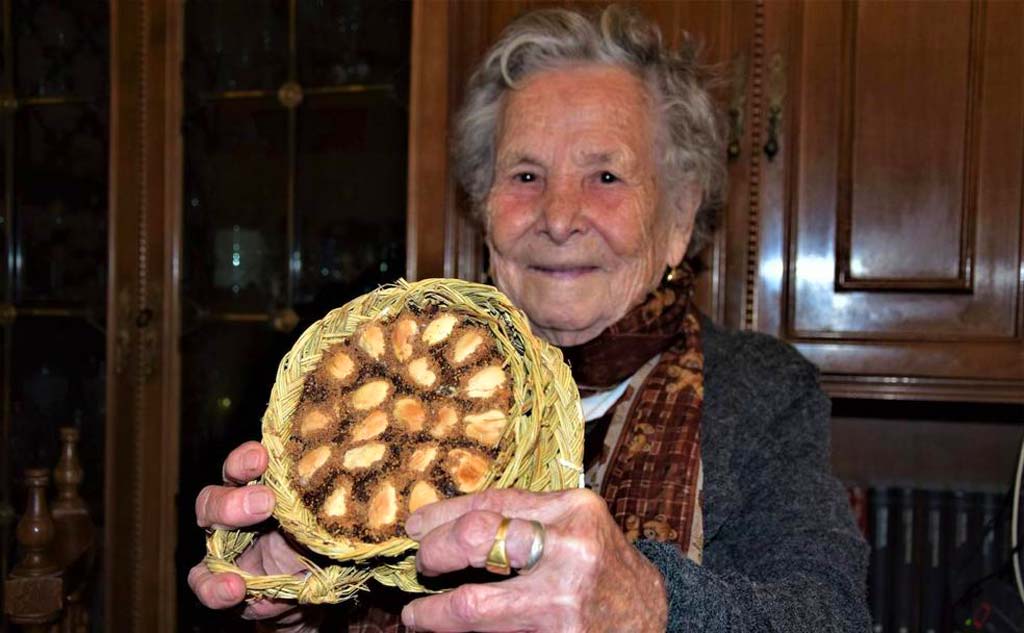
Neighbour of Guájar Faragüit who prepares it with care. We recommend you to read the story behind this photo (© Rafael Vílchez, Ideal Granada).
YEMAS DE LAS MONJAS DE ZAFRA AND OTHER SWEETS. It is customary in Andalusia for sweets to be made in cloistered convents. In fact, in Granada there are more than 10 convents that sell them directly: San Jerónimo, la Concepción, Comendadoras de Santiago, etc. We mention the yolks from the convent of Zafra because we have tried them and we assure you that they do not disappoint. They are normally sold at festivities such as Christmas, Easter and the eve of Easter Week. These sweets are usually made in a 100% handmade way and following traditional recipes. This custom is also maintained in the convents of the towns in the province.
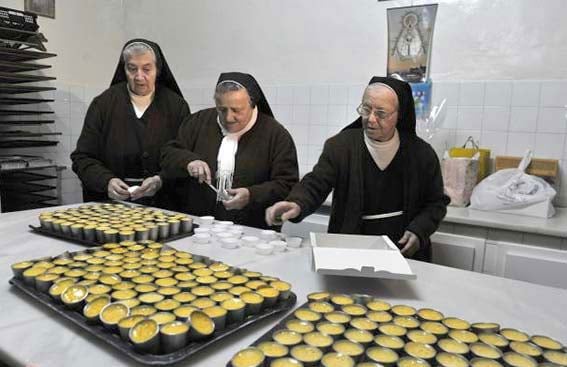
The Poor Clare Sisters of the convent of San Diego in Alhama de Granada preparing their sweets (© Alhama.com).
CUAJADA DE CARNAVAL. We are not talking about the classic milk curd that you can find anywhere in Spain. We are talking about a sweet with angel hair and mantecados and polvorones that are left over from Christmas, sponge cake, custard and syrup. A real sweet bomb of flavour. It is usually decorated with a drawing of the pomegranate fruit and served in a bowl made of Fajalauza, the famous pottery from Granada. Nowadays it can be found all year round, although it is traditionally eaten in the months leading up to carnival, January and February.
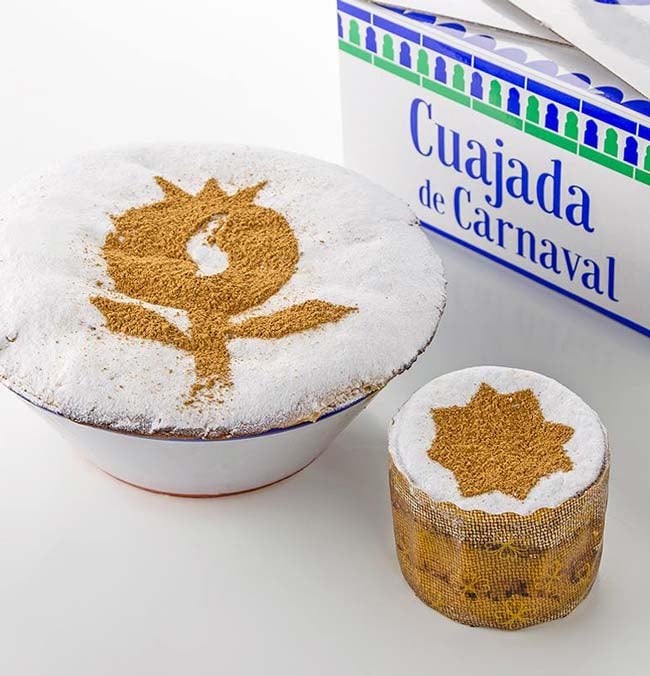
Covered with icing sugar and with the representation of the pomegranate with cinnamon (© Granada de Dulce, where you can buy them from home).
TORTA DE LA VIRGEN. Let’s say you visit Granada in September, you can’t leave without trying the torta de la Virgen. That month is the feast of the patron saint of Granada, the Virgen de las Angustias. The cake is part of the celebration, but also some very characteristic autumn fruits: acerolas, jujubes and pomegranates. These fruits have disappeared from the market in some places, but in the past they were consumed in abundance. The traditional torta de la Virgen is filled with angel’s hair or covered with cracklings, but nowadays it can be found with chocolate. It is another of the must-eat sweets in Granada.
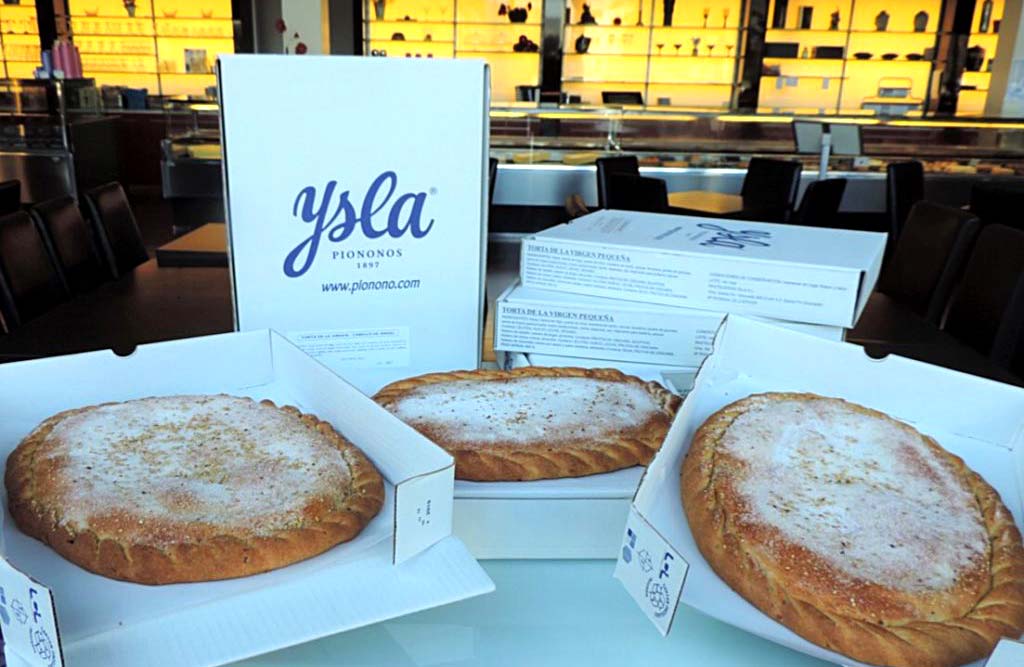
Tortas de la Virgen (Virgin’s Cakes) made by Casa Isla (© Casa Isla).
HORNAZO. This is an oil bread with a boiled egg in the centre. Depending on the geographical area, it has different ingredients; sultanas, aniseed, aniseed, matalauva, lemon zest, etc. And it is also prepared on different dates: Easter, Lent, San Marcos, San José, etc. This sweet cake is shared with the provinces of Jaén, Almería and Málaga.
“LOS ITALIANOS“. From spring until well into autumn this ice-cream parlour is the real queen of ice-creams in Granada. And the truth is that they are delicious. Obviously it’s not a typical recipe from Granada, but every self-respecting granaino has tried their famous “casattas”.

To show you the fame of these ice creams we leave you a funny picture of Spanish politicians tasting it.
PIONONOS. As well as being delicious, it is a 100% Granadan sweet with a lot of history behind it. It originates from Santa Fé, a village near the city of Granada. At the end of the 19th century Ceferino Isla created this unique cake and named it after Pope Pius IX, to whom he was very devoted. And going to the culinary side, the pionono is a juicy cake, but also creamy at the same time. It consists of a layer of sponge cake rolled up and covered with cream.
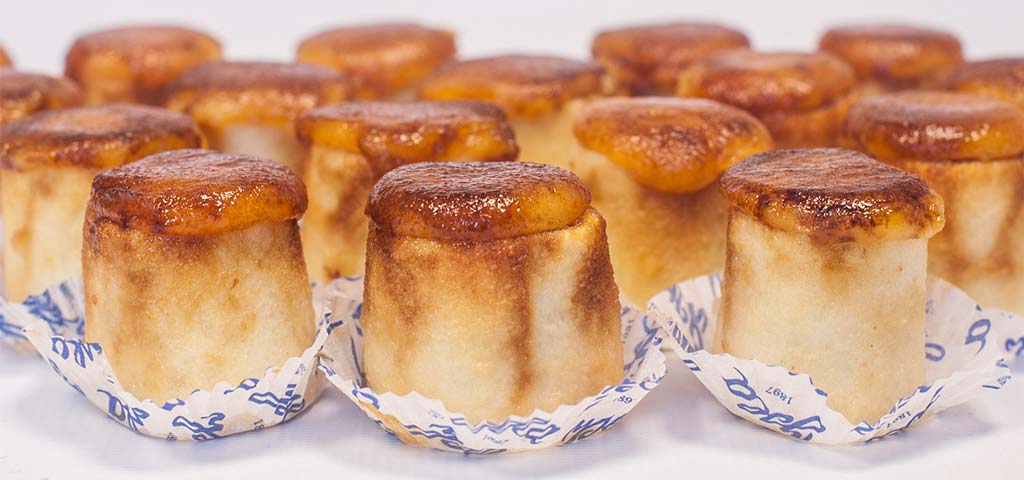
You can find them in many pastry shops, but the original taste is at Casa Isla (© Casa Isla).
OTHER CUSTOMARY DESSERTS though common also in other parts of Spain are pestiños, torrijas de miel, migas con chocolate.
TAPAS IN GRANADA
The tapa is a small portion of food served with a drink in the vast majority of bars in Granada. It is customary throughout Spain to serve “tapas”, only in Granada, Almería and Jaén the tapa is included in the price of the drink. Let’s take a look at some history and what to eat in Granada for tapas.
You might think, almost anywhere in the world there are snacks, snacks and food to accompany a drink! Why has the name “tapa” become so famous and even been exported to other parts of the world?. To answer this question we rely on the explanation offered by Fondo de Olla. They tell us that the real value of tapas lies not in the food itself, but in the action. Going out for tapas or going out for tapas is a social act in which you get together with friends and other people to have a good time.
TAPAS HISTORY
About the name tapa, there are a thousand legends about Alfonso X or other Spanish kings on the web that praise the appearance of the tapa and attribute it to a certain moment in history. However, they are not historically accurate. We summarise a serious article by Frédéric Duhart (University of Mondragón) that you should read if you want to know more about it.
In the Lazarillo de Tormes (an anonymous work from the 16th century) there is one of the first references to the custom of covering wine glasses with food. Throughout the centuries in literature we find allusions to “avisillos” and “incitativos” to refer to the accompaniment of the drink with food.
In a 1903 travel book, Nicolás Rivero recounts his experience at an inn in Seville. He mentions that the wine glasses were covered by a “tapadera” and that this consisted of a thin slice of ham or salami. From then on, references in Andalusia proliferated.
The tapa did not begin to be served in the most popular taverns, but in more respectable establishments. It is therefore a product of modernity and refinement. To us, it reminds us more of a good marketing strategy that was quickly followed throughout Spain.
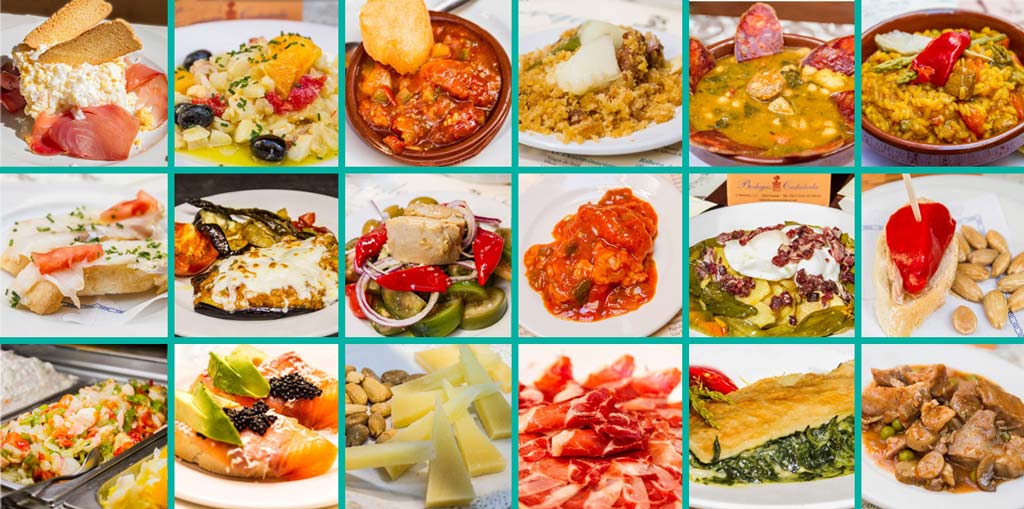
Various tapas at Bodegas Castañeda, in our opinion the bar in Granada that best preserves the gastronomic tradition. From left to right and from top to bottom: prawn salad, “ensaladilla de langostino”, “remojón”, “pisto”, “migas”, “potaje de alubias”, rice, “montadito de bacalao”, stuffed aubergine, tomato with tuna, “ventresca” with cod, “huevos rotos”, “requeté la Castañeda”, “salpicón”, “montaditos” of salmon, cheese and almonds, ham, “empanada de espinacas y piñones” and the classic “carne en salsa” (© Bodegas Castañeda).
GO FOR TAPAS IN GRANADA
Now that you know what tapas are, it’s time to go out for tapas! Yes, it’s time to go out, because tapas are largely eaten in the street. Of course, there are plenty of indoor bars, but even in winter the terraces fill up on sunny days.
In the opinion of many locals, tapas are much better in the neighbourhoods than in the centre or the AlbaicIn. It is true that in these areas there are many poor tapas bars that are slightly more expensive than those in the neighbourhoods, but this is the case in almost all tourist areas. However, in the centre there are also good tapas bars.
As we said, going for tapas is a social event. If you take it easy and start at a good time, you can go on a route. Another of the peculiarities of going for tapas in Granada is to visit several establishments along the tapas route. You can start with the most popular ones and then go on to discover new places.
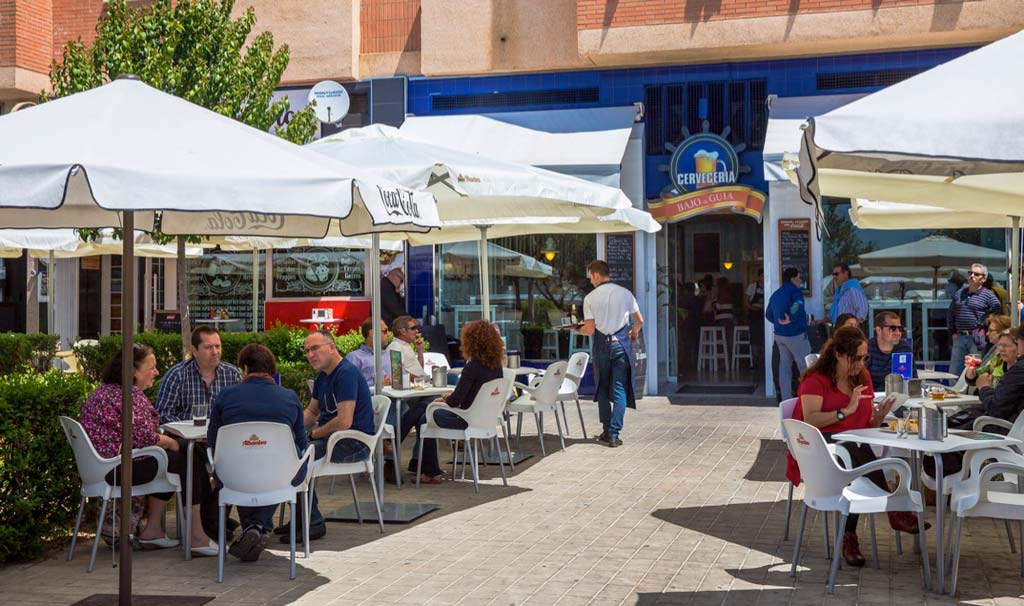
The Bajo de Guía in Granada, not the beach of Sanlúcar de Barramenda, is a bar specialising in fresh fried fish in the northern part of the city.
What to eat in Granada for tapas. Tapas are varied, ranging from international or Mediterranean cuisine to traditional foods in season. It varies depending on the bar.
TAPAS BARS IN THE TOURIST AREA OF GRANADA
To avoid mentioning the usual ones, in the centre we recommend: the Arcos Café Bar (with a very Granadan air of yesteryear), Taberna Gamboa (in the narrow streets behind the Town Hall), Tocateja (if you are looking for something more innovative).
In the Albaicín the Torcuato (a classic), those of the plaza Aliatar where it is customary to eat snails and the Mascarones (for standing tapas).
In the Realejo Los Altramuces and others in Campo del Príncipe, the bar Potemkin, the Candela for some wines and the Damasqueros Bar.
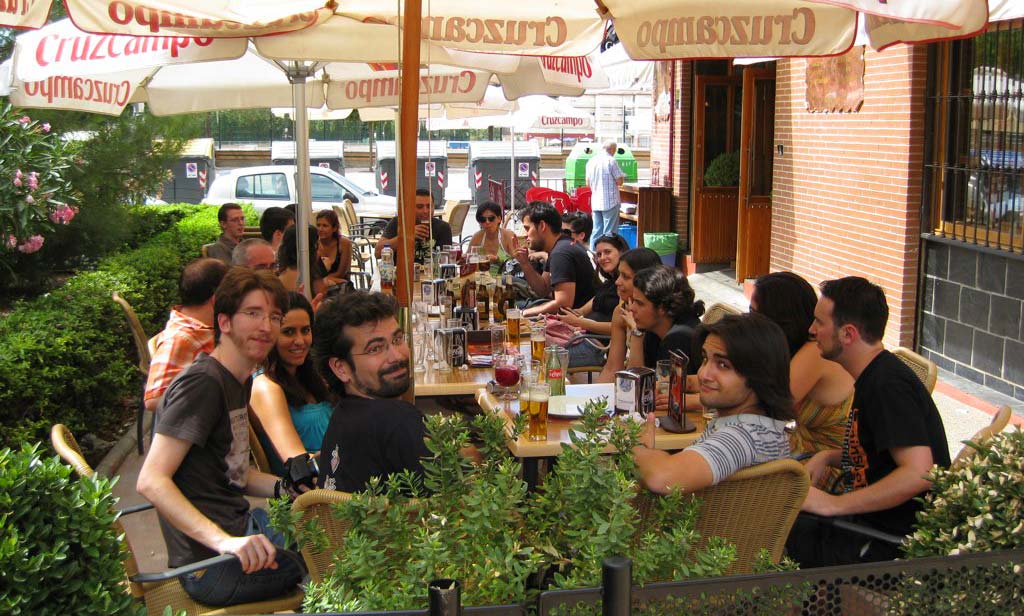
The authentic tapas atmosphere of Granada is experienced in the neighbourhoods: Zaidín, la Chana, Almanjayar. Here the typical Zaidín at midday (José Antonio Gelado, Flickr. CC BY-NC 2.0).
Well, we will also tell you the most famous ones, as some of you may have never been to Granada: Bodegas Castañeda, The Diamonds, The Manuels and Casa Julio. All are in the centre and some have several establishments. They don’t usually disappoint, although there are lesser-known places with the same quality. Also keep in mind that to get a seat in these famous bars you have to get there early or queue up.
SOME TIPS FOR TAPPING
- Tapping is all about having a good time, but try not to disturb the neighbours, be respectful on the terraces.
- Depending on the bar, you can choose the tapa or it will come directly from the kitchen.
- In Granada most bars include the tapa with the drink, although remember that this is not a law, the owners reserve the right to serve it.
- There are also some bars that only serve tapas with alcoholic drinks and not with soft drinks, but they are the fewest.
- Knowing what to eat in Granada, reading this article will help you to differentiate the typical dishes.
WHERE TO TASTE THE GASTRONOMY OF GRANADA
Restaurant Chikito, Casa Juanillo, el Torcuato, Casa Julio or Bodegas Castañeda are some of the oldest bars in Granada. All of them are characterised by serving quality food and, although it sounds like a cliché, combining tradition and modernity.
In the Albaicín many cármenes have become delicious places to have lunch or dinner with spectacular views of the Alhambra. Some serve traditional dishes and cook with local produce.
But since it would take too long to talk about places to eat, we have prepared a special page for this purpose. Here we show you a select group of places to enjoy an excellent gastronomic experience in Granada.
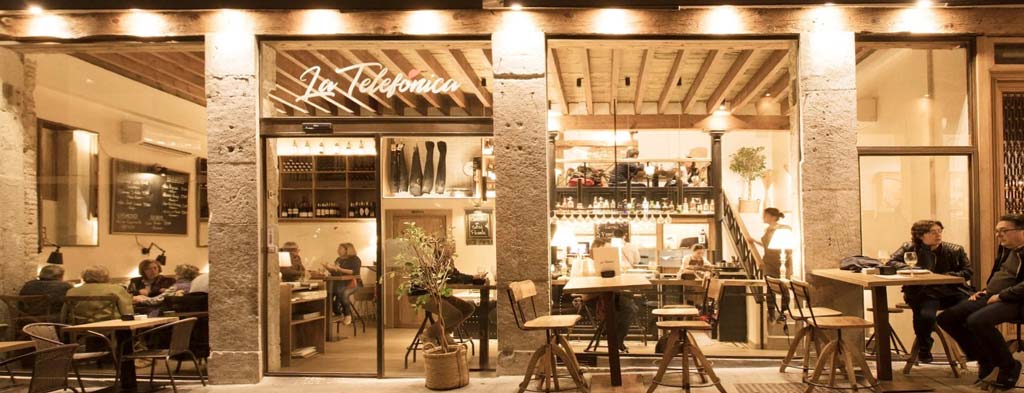
La Telefónica Restaurant, a charming restaurant in the centre of Granada
PLACES OF CULINARY INTEREST
If you like to go to the source of the matter, here is a list of places related to the production, elaboration or commercialisation of food in the province of Granada. If you know of any, let us know in the comments and we will add them to keep this post on “what to eat in Granada” growing.
- Mercado de San Agustín
- Plazas de Abastos of Motril
- Plaza de Abastos of Guadix
- Plaza de Abastos of Baza
- Almazara de Nigüelas. From the 16th century
- Lonja and Fishing Port of Motril
- Granja Maravillas. Cowshed in the Vega of Granada
- Valle de Lecrín. The citrus valley
- Güejar Sierra. Chestnut trees, orange trees and drying sheds
- Olivos Milenarios de Órgiva
- Sierra de la Huétor-Santillán. If you want to pick mushrooms
- Dehesa del Camarate. Cattle breeding
- Vega de Granada. Asparagus cultivation
- Trevélez and surrounding area. Ham dryers
- Señorío de Nevada Winery. Wine cellar
- Ingenio de Motril. Museum
- Ron Montero. Factory
- Riofrío factory
- The fertile plain of any town
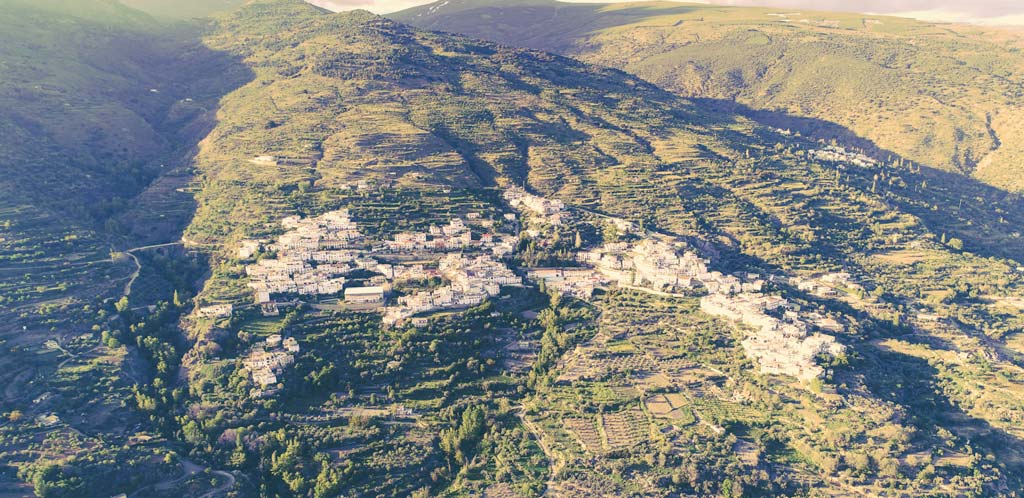
Válor (in the Alpujarra) surrounded by terraces where everything that is necessary to feed oneself is cultivated. This is how close the products of Granada are (© Jorge Sánchez).
Know more about the culture of Granada with this very complete guide.
THANK YOU
We always say it, it is impossible to do these articles without the help of people with extensive popular knowledge. In this case we have been helped by our friends: Vero and Jose from Alfacar; Eva and Jesús from Orce, Pepe from Pitres; Jorge from Yegen.
If you know about the gastronomy of Granada and you want to add something else to the post, help us to improve this article and put it in the comments. What to eat in Granada

